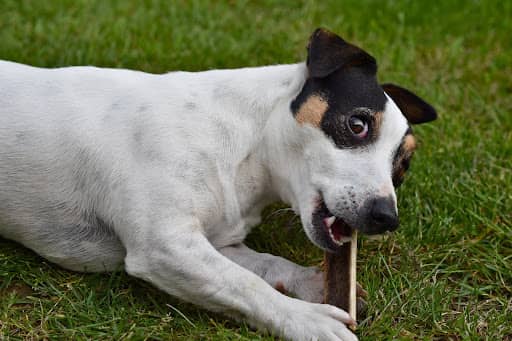
Your dog is part of your family, so of course, you want them to be happy, healthy, and enjoy getting treated once in a while. Dogs and bones seem to go hand-in-hand, with bones being many dogs’ most prized possessions.
We also know that steak has some of the best-looking bones of any animal, especially considering the bones dogs tend to like most. They’re thick and tough to stand up to some of the strongest jaws, and they have lots of yummy meat and marrow to enjoy. But are they safe for dogs to eat?
Are Steak Bones Safe for Dogs?
Just because something looks tasty doesn’t mean it’s safe to eat. Such can be the case with steak bones — but don’t count them out of your dog’s diet just yet.
When given raw, steak bones can be okay for dogs to eat, as long as your dog has a clean bill of health from its veterinarian and excellent dental health. Also, your dog should have some self-control when it comes to chewing rather than one that tries to shred and swallow everything that goes in their mouth.
Types of Bones: Raw steak bones are the better option than cooked steak bones because they don’t splinter as easily. A raw steak bone is stronger, so your dog can chew on it for hours and probably never break a piece off, but a cooked bone can break apart more easily.
With that said, there’s no definitive answer here. Some experts believe steak bones are okay to give once in a while, while others always advise against dogs eating steak bones because of the risks that come with them. For instance, raw bones risk being contaminated with bacteria, and some strong chewers could still break off small pieces that can damage their teeth and digestive system.
Therefore, it’s always best to check with your veterinarian before feeding your dog any steak bones. Your vet completes thorough examinations on your dog and knows its medical history and breed health risks, allowing them to make a more informed decision for your specific pup.
Safety Tips: How to Safely Let Your Dog Enjoy Bones
If your veterinarian gave you the go-ahead to feed your dog steak bones, then consider the following tips to make their bone-chewing experience as safe as possible.
Always Supervise Bone Chewing
The number one rule for dog owners who feed steak bones to their dogs is to supervise their chewing. Always give a bone only when you or someone else will be near your dog to watch, ensuring that they don’t chew the bone until it splinters. This way, you’ll be nearby in case aggressive chewing or choking happens.
Be Aware of Your Dog’s Teeth Health
Before feeding a steak bone to your dog, check with the vet to make sure your dog’s teeth and gums are in good health. Steak bones are strong, and they’ll put a lot of wear and tear on a dog’s teeth. If your dog shows any signs of gum disease or brittle teeth, it’s probably best to stay away from steak bones.
Give Bones After Meals
Does your dog gnaw on a bone like they haven’t eaten in three days? Hint: Most will if they haven’t eaten a meal recently. It’s a good idea to feed your dog a full meal before giving them a steak bone to prevent them from chowing down aggressively on the bone. They’ll feel fuller and will be less likely to try to eat the bone whole.
Avoid Small Bones
A steak bone should always be larger than the mouth of the dog you’re feeding it to. Dogs eating too-small bones run the risk of accidentally swallowing it, which can lead to choking or a digestive obstruction. A good rule of thumb is to feed a bone that’s longer than the dog’s muzzle.
Throw Them Away
Steak bones can get a buildup of bacteria from the raw meat that was once on them. It’s best to store them in the refrigerator when your dog isn’t chewing them and only allow your dog to chew for 15 minutes maximum to avoid bacteria spreading at room temperature. After three or four days, throw the bone away.
Better Option: Feed Your Dog Steak!
If your dog loves steak bones but doesn’t chew them safely or your vet recommends not giving them, there’s another option: steak meat. But, again, clear this with your vet, as some dogs may have allergies, sensitivities, or other reasons why they shouldn’t eat steak.
But nutritionally, steak is an excellent source of protein for dogs, which is why you’ll find beef in many dog foods. Plus, it contains lots of Omega-6, a healthy fat when eaten in moderation. As polyunsaturated fats, Omega-6 fatty acids lower bad cholesterol and raise good cholesterol, making them heart-healthy.
Cooked steak for dogs can be an excellent addition to a meal or used as a quick treat. Just be sure to remove the bones and avoid using seasonings, gravies, oils, or other additions that could be unsafe for dogs to ingest.
Steak Bones for Dogs
In summary, if you’re considering feeding your dog steak bones — or steak for that matter — talk to a veterinarian first. Your vet can determine whether bones or steak is okay for your dog to have based on their physical and dental health. If your dog gets the green light to have some steak or bones, your vet can offer safe and healthy feeding suggestions.
And if you do decide to give your dog some steak, make sure it’s some of the best. Chicago Steak Company’s commitment to excellence makes our wet and dry-aged steaks stand out from the pack. They’re hand-selected and hand-cut, and each package sent your way gets its own registration number as our guarantee to you that we stand behind everything we sell.

